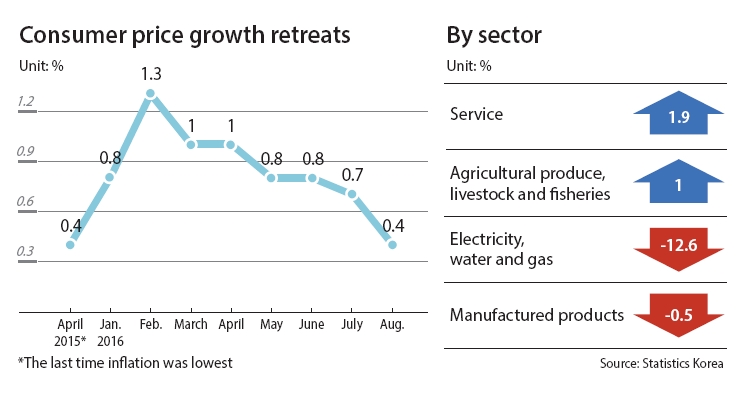Inflation rate hits a 16-month low in August

However, despite the low inflation rate, Koreans, especially those in middle and low-income households, are burdened by the continuing price hike in produce, which is expected to worsen with the sluggish economy.
In August, the country’s consumer prices rose 0.4 percent year on year, the lowest growth since April 2015, when the prices also rose 0.4 percent, the government said on Thursday.
“The slow growth rate is mainly due to the government’s decision made last month to give discounts on electricity bills for households,” said Yoo Soo-young, a director at the Ministry of Strategy and Finance. “The inflation rate in August would be around 0.8 percent if the changes in electricity billing systems were not made.”
In fact, the government has decided to discount household electricity bills from July to September, as lawmakers and many residents found the current progressive billing system unfair or said it burdened households. During the heat wave, angry residents called for changes to the system.
“The fall in crude oil prices not only impacted the price of petroleum products but also dragged down the overall prices for electricity, water and gas,” Yoo said.
Prices for electricity, water and gas fell 12.6 percent in August compared to the previous year, contributing to lowering inflation by 0.57 percentage points.
Petroleum prices dropped 8.8 percent over the year, mirroring the fall in international crude prices, lowering inflation by another 0.37 percentage points. Gasoline prices fell 8.2 percent and diesel prices dropped 7.6 percent compared to a year ago.
Even though the overall inflation rate slowed, basic living expenses and consumer prices of food increased last month, tightening living conditions for low and middle-income households.
Prices of fresh produce rose 2.8 percent compared to the previous year and the prices of other food, including agricultural produce, livestock and fishery products increased 1 percent.
“The prices of vegetable rose significantly from the previous year due to the hot weather,” said Yoo at the Finance Ministry.
The prices of vegetables alone rose 6.2 percent year-on-year last month.
Napa cabbage prices jumped 58 percent, pepper became 30.9 percent more expensive and the cost of garlic rose 17.5 percent. The cost of Korean beef, or hanwoo, rose 13.7 percent, but pork prices dropped 4.5 percent. These products are widely used during Chuseok, the Korean Thanksgiving, which is just two weeks away.
Service prices, including rent, utility bills, travel and dining, in August increased 1.9 percent year-on-year, contributing to raising overall inflation by 1.07 percentage points. The cost of rent, including jeonse, or lump-sum rental deposits, was up 2.5 percent compared to the previous year.
The price of the Korean liquor soju sold in restaurants and bars rose 13.2 percent, and the prices of raw fish meals at restaurants increased 5.2 percent, according to Statistics Korea.
Consumer prices rose the most in Busan by 0.8 percent, followed by Seoul (0.7 percent) and Gwangju (0.6 percent). Inflation was lowest in Gumi, North Gyeongsang, and Jinju, South Gyeongsang, which each saw inflation drop 0.3 percent in August.
“The discounts on electricity bills are going to expire in October and we expect the inflation rate to move up to around 1 percent later this year as it did before,” said Yoo. “Global oil prices are showing signs of recovering and it appears that some of the downward pressure from overseas will be reduced.
“The government will monitor consumer and global oil prices thoroughly and will try its best to stabilize the local retail and agricultural industries so that they can be prepared for Chuseok.”
The government statistics agency researched 481 major goods Koreans purchase in 37 major cities and provinces.
BY KIM YOUNG-NAM [kim.youngnam@joongang.co.kr]










with the Korea JoongAng Daily
To write comments, please log in to one of the accounts.
Standards Board Policy (0/250자)